The only valid cutlery review is one that uses the blade for the purpose it was designed.
That’s how I checked out the Bark River Machete. It was wrung out on one of the most abrasive and challenging mediums imaginable – bamboo. Here’s a second look at how it worked out.
by Leon Pantenburg
Disclaimer: Knivesshipfree.com and DLT Trading are Survivalcommonsense sponsors. I did not get a free knife, and I was not paid to write this review. All opinions expressed in this post are mine, and neither KSF, DLT nor Bark River have any input into this review. All I ever promise is a fair shake.
As soon as the Bark River Machete arrived, I started looking for a realistic way to test it. I use machetes to help build igloos and snow shelters, but there’s not much opportunity for that in Mississippi.
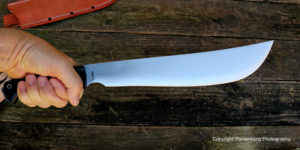
The Bark River Machete is a superb survival tool. It won’t let you down, when the chips are down.
But an overgrown bamboo thicket that needed thinning was perfect. Bamboo has a silicate in the fibers, which makes it very strong, but also abrasive. Several hundred of the plants, in various sizes needed to be removed, so I took several machetes out and started hacking. Now, the job is done and I have learned a lot about Bark River’s big knife. (Here is the initial BR Machete review).
Bark River Machete specs, courtesy of Knivesshipfree.com
| Overall Length: | 17.5″ |
| Blade Length: | 12″ |
| Blade Height: | 2.2 |
| Blade Steel: | CPM-1V |
| Blade Thickness: | .125″ |
| Weight: | 16oz. |
I started out using the machete when it was razor sharp, direct from the factory. The most efficient method, I discovered, was to take a swing at the trunk, at a 45-degree angle about knee high. Most of the medium-sized plants (1-2 inches in diameter) could be taken out with one whack. Others, some with three to four inch diameters took a few more strokes. I also took out a couple of oak saplings on the way to my deer stand. I could fell the trees as quickly as I could move through the thicket.
I had a chainsaw at hand (Incidentally, I love using chainsaws and am pretty proficient with one), but in this case, the saw wasn’t the most effective tool to use. The saw required two hands, and there was always a chance the tree would fall the wrong way. Also, the tops tended to intertwine, and sometimes I had to cut several before they would fall down.
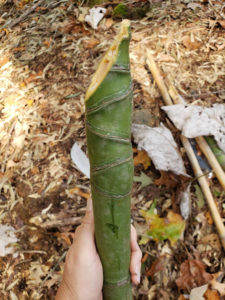
This large bamboo tree was cut with one hit.
The knee-high stumps bore an eerie resemblance to punji sticks from the Vietnam War, and they would have to be removed. An ax worked fine for that, but the chainsaw cut the stumps off even with the ground. By the time I got all the stumps removed, my shoulders and lower back reminded me how many birthdays I’d had!
Here’s the good stuff:
Handling: Two other excellent machetes of similar sizes were taken along for comparison. But there was no comparison. The BR was so well balanced that it made handling a breeze. I could chop more accurately and with less effort with the BR. This is a big deal when you have to hit the same place on the trunk several times to bring the tree down. It’s also a big deal when you are chopping shooting lanes from the deer stand or clearing trails. Accuracy means you can accomplish the job with fewer strokes. (Read: Do you need a machete?)
Balance: This is important on a big knife. A machete needs to be a little point heavy, because of the length of the blade, but it has to be balanced well or you will tire easily using it. Also, the balance contributes to accuracy, and directly impacts the velocity that can be transmitted to the cut.
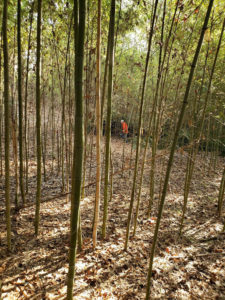
This is just some of the bamboo that was removed with the machete.
Grind: This field test forever puts me in the convex grind camp. The other two machetes had abrupt flat grinds that were almost scandis. The BR bit deeper with less effort. It also worked better for trimming off the smaller limbs. My wife Debbie was working with me – she wanted some good bamboo to make wind chimes. She noticed that the BR was easier to use.
Steel: CPM 1V is new to me. But if this test is any indication, I hope to see a lot more of it used. I was utterly amazed at how well it held up to brush clearing. Inevitably, when you are chopping out brush, you will hit dirt. And a working knife gets tossed onto the ground from time to time when you pick up another tool. This steel didn’t stain (yet), and I’m guessing that a little maintenance work will keep the blade shiny for a long time.
Edge holding: This aspect was over the top, and I am still awed by how sharp the blade stayed even after cutting several hundred bamboo trees. I tried the blade on some paper when I got home, not expecting anything. To my surprise and delight, the blade was still sharp enough to whittle paper. A few quick swipes on my grandfather’s butchering steel and a quick strop on plain leather restored the the razor edge.
Choil: I think a choil, that ground out part of the blade next to the handle, is a waste of steel. The idea is that the choil allows the user to “choke up” on the blade for fine carving. It removes one of the most useful parts of the blade, and negates the built-in safety of the handle. And besides, who buys a machete to whittle or do wood carving with? But if you decide you must use the choil on this blade, the video below shows how to be safe.
So do you need a Bark River Machete?
Initially, I would have said no, and didn’t really know why I bothered to order the Bark River Machete. I already had a half dozen machetes, and they worked fine. I use my machetes for a multitude of tasks, ranging from clearing brush, to trimming snow blocks to make igloos.
The BR machete starts out at $217.45, and that’s a lot of money for a tool you will beat the hell out of. Besides, you can get a good machete for under $20 virtually anywhere. In Nicaragua, my daughter, as a joke, bought me a machete on the street that set her back about $4 American. The excellent Tramontina 12-inch blade machete costs less than $15 on Amazon.
But, IMHO, this Bark River is very superior to any machete I’ve tried. Cutting bamboo, in several instances, I would make the initial chop with one machete, follow with another whack from another and finish with the third. I was not able to cut down a bamboo with a single stroke with either of the other blades. They didn’t bite as deep, and it took more effort to use them. Do the math – if it takes two or three extra chops to get a tree down, how much faster will the user’s arm wear out?
By comparison, the BR cut like a lazer, and the edge lasted a lot longer than my arm did.
If you are looking for an investment survival tool, or a solid candidate for the “Best Survival Knife” get the Bark River. I’m keeping mine, and it will likely ride in my car Get Home Bag. The BR Machete has everything you need in a survival machete.
Except for that damned choil. It doesn’t need a choil. I hope the next run doesn’t have them.
Please click here to check out and subscribe to the SurvivalCommonSense.com YouTube channel – thanks!

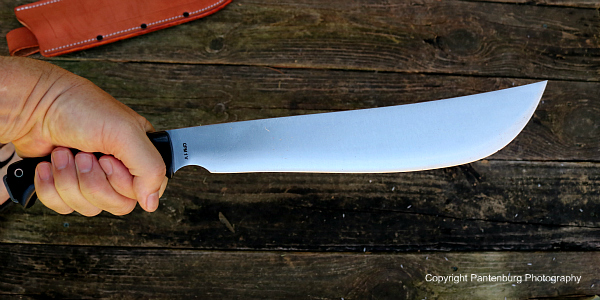
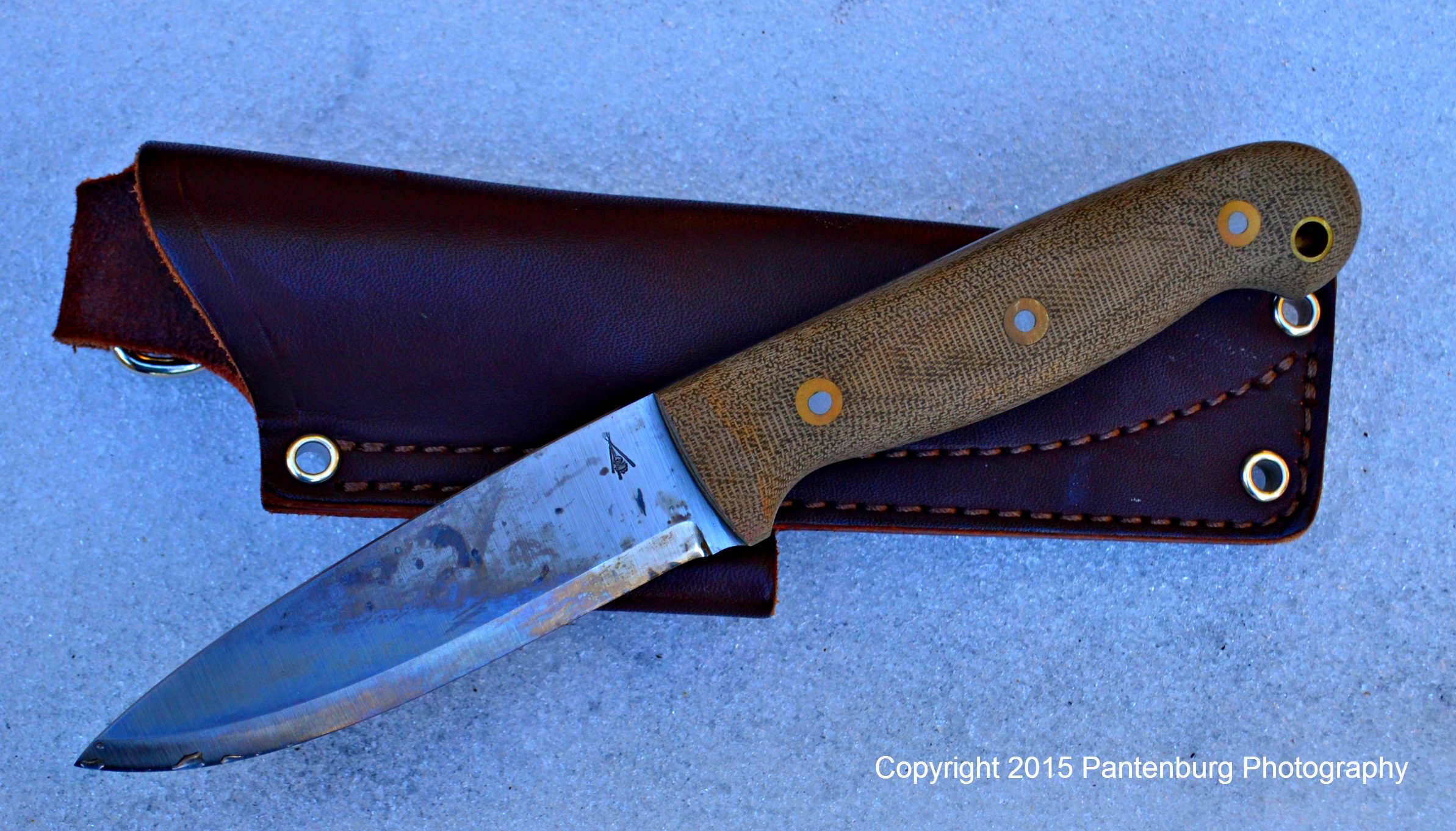
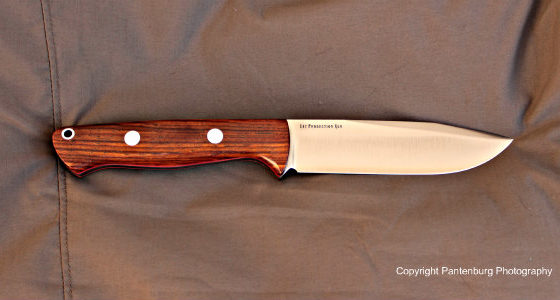
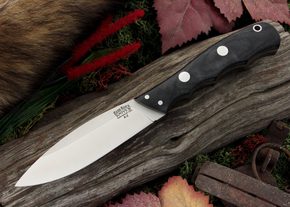
Leave a Reply